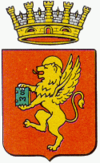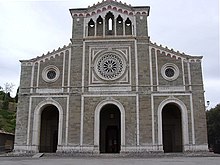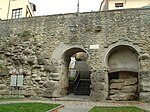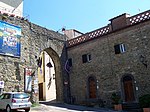Cortona
| Cortona | ||
|---|---|---|

|
|
|
| Country | Italy | |
| region | Tuscany | |
| province | Arezzo (AR) | |
| Coordinates | 43 ° 16 ' N , 11 ° 59' E | |
| height | 494 m slm | |
| surface | 342 km² | |
| Residents | 21,795 (Dec. 31, 2019) | |
| Population density | 64 inhabitants / km² | |
| Post Code | 52044 | |
| prefix | 0575 | |
| ISTAT number | 051017 | |
| Popular name | Cortonesi | |
| Patron saint | Margaret of Cortona , Santa Croce (September 14th) | |
| Website | Cortona | |
 Panorama of Cortona |
||
Cortona is an Italian city with 21,795 inhabitants (as of December 31, 2019) and is located in the province of Arezzo in the Tuscany region .
geography
Cortona is located north of Lake Trasimeno in the climatic classification of Italian municipalities in Zone E, 2 282 GG. The provincial capital Arezzo is 24 km northwest, the regional capital Florence 80 km northwest. Cortona is located in the southeast of the province of Arezzo. In the south the place borders on the province of Siena , in the east on the region of Umbria ( province of Perugia ).
The place is in the Chiana Valley (Italian: Val di Chiana ), the eponymous canal flows through the municipality over a length of 10 km. Other important bodies of water are the Torrenti Mucchia (18 of 24 km in the municipality) and Esse (every 17 km in the municipality), which belong to the Arno river system , as well as the Minimella (every 7 km in the municipality) and Seano (7 of 8 km in the Municipal area), which belong to the river system of the Tiber .
The districts include Camucia - Monsigliolo (273 m, approx. 5500 inhabitants), Chianacce (285 m, approx. 115 inhabitants), Cignano (336 m, approx. 50 inhabitants), Col di Morro (680 m, approx. 30 inhabitants ), Creti (273 m, approx. 70 inhabitants), Fratta - Santa Caterina (265 m, approx. 470 inhabitants), Fratticciola (278 m, approx. 100 inhabitants), Mercatale (309 m, approx. 415 inhabitants), Mezzavia , Montalla , Montecchio (283 m, approx. 400 inhabitants), Ossaia (292 m, approx. 230 inhabitants), Pierle (468 m, approx. 30 inhabitants), Pietraia , Poggioni , Riccio , Ronzano , Sant'Andrea di Sorbello , Sodo , Terontola (270 m, approx. 1600 inhabitants), Terontola Alta (314 m, approx. 200 inhabitants), Tornia and Torreone .
The neighboring municipalities are Arezzo , Castiglion Fiorentino , Castiglione del Lago ( PG ), Città di Castello (PG), Foiano della Chiana , Lisciano Niccone (PG), Montepulciano ( SI ), Sinalunga (SI), Torrita di Siena (SI), Tuoro sul Trasimeno (PG) and Umbertide (PG).
history
According to legend, the city was founded by the Pelasgians , but in reality it was founded by the Etruscans and was one of their oldest and most important cities. Her Etruscan name was Curtun . With Rome the city was in the 4th century BC. . Chr ally. The Romans conquered it in 310 BC. Chr.
In the second Punic War , the Carthaginian army under Hannibal Cortona marched through the Apennines in March 217 BC. Chr .; a few days later it won the battle on Lake Trasimeno a few kilometers southeast of the city.
The Goths conquered Cortona in the 5th century AD and the Aretines occupied the city from 1258 to 1260. The city has been a bishopric since 1325 . At the same time the family who took Casali the Signoria in and held these eighty years as a free commune independent. Then the place got into a conflict of interest between Arezzo, Florence and Siena , until 1409 Ladislaus of Naples took over the rule of the place and two years later gave it to Florence.
The almost 300 year old Accademia Etrusca determined the social and intellectual life of the city for centuries. The Accademia operates the Biblioteca del Comune e dell'Accademia Etrusca and the Museo dell'Accademia Etrusca . In 1992 the Tabula Cortonensis was discovered in the Località Le Piagge .
Attractions
cathedral
The Cathedral of Cortona of the Assumption of the Virgin Mary ( Concattedrale di Santa Maria Assunta ) stands on the remains of an ancient temple and was first mentioned as a parish church in the 11th century . In 1507 it became the cathedral of the diocese of Cortona, founded in 1325 (previously San Vincenzo on the outskirts of the city), 1986 co- cathedral of the diocese of Arezzo-Cortona-Sansepolcro . The essentially Romanesque church is outwardly rather inconspicuous, but the interior was redesigned in elegant Renaissance forms from the middle of the 15th century , later partly in Baroque style .
Santa Maria Nuova
There are two typical Renaissance churches in Cortona, which illustrate two different building principles. Santa Maria Nuova, built in 1554, is a square-plan church that sits outside the city walls. The renaissance had taken up the ideal of the central building again in church construction . This church offers the simple version of such a central building.
Madonna del Calcinaio
Only a few hundred meters further is the “Madonna del Calcinaio”, Cortona's most important work of art. It was built from 1484 to 1515 by Francesco di Giorgio Martini (1439–1502) because of an allegedly miraculous image of the Virgin. This image was originally on the walls of a lime pit, a calcinaio , hence the name; today it is inserted in the tabernacle above the high altar. In cases like here, where a nave was created in the Renaissance despite the central building ideal, mostly the eastern part of the building was made into such a central building, which was then crowned with a mighty dome - similar to the Florentine cathedral .
From the outside the church looks inconspicuous, inside it has been extensively restored. The church has unusually high vaults. Here, too, the decisive features of Renaissance architecture can be recognized: clear, geometric shapes, a combination of rectangular shapes with round arches and circles, antique-style gable windows, accentuation of the flat walls, which are kept entirely in white.
Basilica di Santa Margherita
The basilica is dedicated to Margaret of Cortona and was started in 1856 by Enrico Presenti. In 1876, Mariano Falcini took over the construction management. It was completed in 1897 by Giuseppe Castellucci. The basilica was built over an older church building from the 13th / 14th centuries. Created in the 16th century, the central building was preserved. This in turn originated from an oratorio that arose from the cell of Saint Margaret. She died there in 1297. The campanile dates from 1650. Inside is the Immacolata concezione by Francesco Vanni .
Other religious buildings
- Farneta Abbey
- Chiesa di Sant'Agostino , church from the 13th century.
- Chiesa di San Benedetto , church from the 17th century.
- Chiesa di San Cristoforo , church from the late 12th century. Was restored in 1575 due to a fire.
- Chiesa di San Domenico , church from the 15th century adjoining the city walls. Contains the work Madonna con Bambino tra due Santi domenicani by Fra Angelico .
- Chiesa di San Niccolò , church in the center from the 15th century, the facade was restored in 1930.
- Chiesa di Santa Chiara , 16th century church and convent designed by Giorgio Vasari .
- Chiesa di San Francesco , the first after Francis of Assisi named church outside of Assisi , origin of the Laudario Di Cortona in the 13th century.
- Chiesa dello Spirito Santo , church just outside the city walls near Porta Guelfa. Created in 1637 by Francesco Berrettini.
- Chiesa di San Vincenzo , was a cathedral from 1325 to 1508 and was destroyed in 1785.
- Convento delle Celle , convent on the mountain Sant'Egidio north of the city, which was documented as a hermit cell as early as 1199.
- Cistercian Abbey of Santissima Trinità
Palazzi
- Palazzo comunale (town hall) was first mentioned in writing in the 12th century.
- Palazzo Casali (also called Palazzo Pretorio in Florentine times ), palace of the family of the same name, which was built in the early 15th century. The facade dates from 1608 and was created by Filippo Berrettini. Luca Signorelli had his workshop here in 1502. Today the seat of the Accademia Etrusca and museum of the collections.
- Palazzo Passerini , building in Piazza della Repubblica. Hosted Pope Leo X in 1515 .
Fortezza del Girifalco
The fortress, also called Fortezza Medicea , di Cortona or Rocca , is located at the highest point of Cortona. It was first mentioned in writing in 1258 when Arezzo took control of the place. Further expansion took place under the Signoria dei Casali and through Siena until 1411 Florence and the Medici gained the upper hand over the city. Under Cosimo de 'Medici , the fortress was reinforced again. Architects were Gabrio Serbelloni and Francesco Laparelli . The fortification consists of the four bastions Bastione Sant'Egidio , Bastione San Giusto , Bastione Santa Maria Nuova , Bastione Santa Margherita and the Maschio ( Mastio ; main tower).
Rocca di Pierle
The castle, also called Castello di Pierle , is located on the side facing Umbria near the local border with Lisciano Niccone . It is a ruined castle on Monte Maestrino that has belonged to the Counts of Del Monte since the 11th century . The castle was given to the Oddi from Perugia by Bernabò Visconti in the 14th century as a feudal system and then acquired by the Casali . Francesco Casali renovated the castle in 1371, but it was destroyed in 1587 on the instructions of Ferdinando I de 'Medici . It is still visible today as a well-preserved ruin and is currently being renovated. The entrance to the castle used to be via a drawbridge. The castle used to have two towers, of which only the north tower has been preserved. The castle palace was 28 meters high and had seven floors, the first, third and fifth with vaults and the other four floors with wooden ceilings. Today, in addition to the north tower, the palace, the gatehouse, the grooves of the drawbridge and two towers and defensive walls with loopholes are still visible.
City wall and city gates
The city wall of the Etruscans from the 5th century BC. BC had a length of 2 km, some parts of which are used by the medieval city wall. It has a length of approx. 3 km and the following seven city gates:
- Porta Berarda , the city gate facing southeast
- Porta Colonia , city gate in the north that leads to Santa Maria Nuova. Was probably the north gate of the Cardo
- Porta Ghibellina , also called Porta Bacarelli or Porta Bifora , western city gate
- Porta Guelfa , also called Porta Sant'Agostino , southernmost city gate and main gate at Cardo maximus
- Porta Montanina , north-facing city gate
- Porta Santa Maria , western city gate on Via Roma
- Porta Santa Margherita , the northern city gate with the missing arch, leads to the Basilica di Santa Margherita
Events
- Giostra dell'Archidado , medieval festival from 1397 when Francesco Casali and Antonia Salimbeni were married. The festival has been held annually on the second Sunday in June since 1994 and is held in Piazza Signorelli. Here the five districts of Santa Maria (red-blue colors), San Vincenzo (yellow-blue), Peccioverardi (white-yellow), Sant'Andrea (green-yellow) and Poggio-San Marco (red-green) compete in crossbow shooting on.
traffic
- Cortona has a junction on the Raccordo autostradale 6 motorway slip road .
- The place is connected to the railway system with the stations Terontola-Cortona and Camucia-Cortona . Both stops are on the Florence-Perugia railway line.
City and community partnerships
Cortona maintains the following cities community partnerships :
-
 Château-Chinon , Burgundy ( France ), since 1962
Château-Chinon , Burgundy ( France ), since 1962 -
 Athens , Georgia ( United States ), since 1978
Athens , Georgia ( United States ), since 1978 -
 Kruja ( Albania ), since 1995
Kruja ( Albania ), since 1995
sons and daughters of the town
- Guido von Cortona (1187–1247), one of the early followers of St. Francis of Assisi , Blessed, relics in the Cathedral of Cortona
- Urbano da Cortona (1426–1504), sculptor and painter
- Luca Signorelli (1441–1523, probably born in or near Cortona), important painter of the Florentine Renaissance
- Silvio Passerini (1469–1529), cardinal
- Francesco Laparelli (1521–1570), engineer and builder
- Filippo Venuti (1531–1587), translator, Latinist, Italianist and lexicographer
- Bernardino Radi (1581–1643), draftsman and architect
- Michelangelo Amadei (1586–1642), composer, from 1606 Kapellmeister at the city's cathedral
- Pietro da Cortona (1596–1669), important builder and painter of the Roman high baroque
- Domenico Cecchi called " il Cortona " (approx. 1650 / 55–1717), famous opera singer and castrato
- Antonio Baldi (proven from 1710 to 1735), former castrato and opera singer, Handel interpreter
- Gino Severini (1883–1966), painter of Futurism
- Alice Ricciardi-von Platen (1910–2008), doctor and psychoanalyst
- Benvenuto Italo Castellani (* 1943), Archbishop of Lucca
literature
- Cortona. città d'arte , Arti Tipografiche, Cortona
- Emanuele Repetti: CORTONA nella Val di Chiana (Cortona un dì Croton e Corytum). In: Dizionario Geografico Fisico Storico della Toscana (1833–1846), online edition of the University of Siena (PDF, ital.)
- Touring Club Italiano : Toscana. Milan 2003, ISBN 88-365-2767-1 , pp. 728-741.
Web links
- Official website of the municipality of Cortona (Italian)
- Information on the municipality of Cortona (Italian)
- Cortona in the Enciclopedia Italiana (1931) (Italian)
Individual evidence
- ↑ Statistiche demografiche ISTAT. Monthly population statistics of the Istituto Nazionale di Statistica , as of December 31 of 2019.
- ↑ Website of the Agenzia nazionale per le nuove tecnologie, l'energia e lo sviluppo economico sostenibile (ENEA), accessed on August 7, 2013 (Italian) (PDF; 330 kB)
- ^ Official website of the Sistema Informativo Ambientale della Regione Toscana (SIRA) on the rivers in Cortona , accessed on August 8, 2013 (ital.)
- ↑ Official website of the ISTAT ( Istituto Nazionale di Statistica ) on the 2001 population figures in the province of Arezzo, accessed on August 7, 2013 (Italian)
- ↑ a b c d e f g h TCI
- ↑ Günther Binding : Master of Architecture. History of the architect and engineering profession . Scientific Book Society Darmstadt 2004, p. 158
- ↑ a b c d e f g h i Cortona. città d'arte
- ↑ Website Castelli Toscani for Fortezza del Girifalco , accessed on August 7, 2013 (ital.)
- ↑ Official website of the city of Cortona on the history of the place , accessed on August 7, 2013 (Italian)
- ↑ The Fortezza Girifalco at Fortezze.it with map and illustration, accessed on August 7, 2013 (ital.)
- ^ Website Castelli Toscani for Castello di Pierle , accessed on August 9, 2013 (ital.)
- ↑ Rocca di Pierlé MEDIEVAL CASTLE http://www.luxuryitalianproperty.it/en/rocca_pierle_cortona_tuscany/luxury_italian_property_for_sale.php
- ↑ site for Giostra dell'Archidado retrieved (ital.) On August 9, 2013
- ↑ Official website of the city of Cortona on the city and community partnerships , accessed on August 8, 2013 (ital.)

















